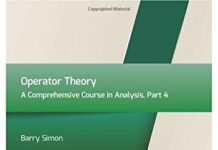
Ebook Info
- Published: 1979
- Number of pages: 463 pages
- Format: PDF
- File Size: 9.35 MB
- Authors: Barry Simon
Description
Scattering theory is the study of an interacting system on a scale of time and/or distance which is large compared to the scale of the interaction itself. As such, it is the most effective means, sometimes the only means, to study microscopic nature. To understand the importance of scattering theory, consider the variety of ways in which it arises. First, there are various phenomena in nature (like the blue of the sky) which are the result of scattering. In order to understand the phenomenon (and to identify it as the result of scattering) one must understand the underlying dynamics and its scattering theory. Second, one often wants to use the scattering of waves or particles whose dynamics on knows to determine the structure and position of small or inaccessible objects. For example, in x-ray crystallography (which led to the discovery of DNA), tomography, and the detection of underwater objects by sonar, the underlying dynamics is well understood. What one would like to construct are correspondences that link, via the dynamics, the position, shape, and internal structure of the object to the scattering data. Ideally, the correspondence should be an explicit formula which allows one to reconstruct, at least approximately, the object from the scattering data. The main test of any proposed particle dynamics is whether one can construct for the dynamics a scattering theory that predicts the observed experimental data. Scattering theory was not always so central the physics. Even thought the Coulomb cross section could have been computed by Newton, had he bothered to ask the right question, its calculation is generally attributed to Rutherford more than two hundred years later. Of course, Rutherford’s calculation was in connection with the first experiment in nuclear physics.
User’s Reviews
Reviews from Amazon users which were colected at the time this book was published on the website:
⭐This book cover only one subject scattering. It use the Kato Birman theory and avoids the Mourre estimate theory (which appears later). consequently the subject covered are very old.The only interest of this book is for teaching, it explains carefully the traps and difficulties of quantum scaterring and gives a great set of examples.
⭐Not found.
⭐Not found.
⭐Not found.
Keywords
Free Download Scattering Theory (Methods of Modern Mathematical Physics, Vol. 3) (Volume 3) 1st Edition in PDF format
Scattering Theory (Methods of Modern Mathematical Physics, Vol. 3) (Volume 3) 1st Edition PDF Free Download
Download Scattering Theory (Methods of Modern Mathematical Physics, Vol. 3) (Volume 3) 1st Edition 1979 PDF Free
Scattering Theory (Methods of Modern Mathematical Physics, Vol. 3) (Volume 3) 1st Edition 1979 PDF Free Download
Download Scattering Theory (Methods of Modern Mathematical Physics, Vol. 3) (Volume 3) 1st Edition PDF
Free Download Ebook Scattering Theory (Methods of Modern Mathematical Physics, Vol. 3) (Volume 3) 1st Edition





